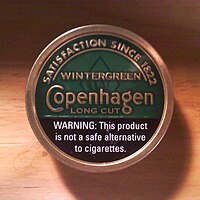
Tobacco is the common name of several plants in the genus Nicotiana of the family Solanaceae, and the general term for any product prepared from the cured leaves of these plants. More than 70 species of tobacco are known, but the chief commercial crop is N. tabacum. The more potent variant N. rustica is also used in some countries.

Gutka, ghutka, guṭkha or betel quid is a chewing tobacco preparation made of crushed areca nut, tobacco, catechu, paraffin wax, slaked lime and sweet or savory flavourings, in India, Pakistan, other Asian countries, and North America.

Snus is a tobacco product, originating from a variant of dry snuff in early 18th-century Sweden. It is placed between the upper lip and gum for extended periods, as a form of sublabial administration. Snus is not fermented. Although used similarly to American dipping tobacco, snus does not typically result in the need for spitting, and, unlike naswar, snus is steam-pasteurized.

Nicotine replacement therapy (NRT) is a medically approved way to treat people with tobacco use disorder by taking nicotine through means other than tobacco. It is used to help with quitting smoking or stopping chewing tobacco. It increases the chance of quitting tobacco smoking by about 55%. Often it is used along with other behavioral techniques. NRT has also been used to treat ulcerative colitis. Types of NRT include the adhesive patch, chewing gum, lozenges, nose spray, and inhaler. The use of multiple types of NRT at a time may increase effectiveness.

Chewing tobacco is a type of smokeless tobacco product that is placed between the cheek and lower gum to draw out its flavor. It consists of coarsely chopped aged tobacco that is flavored and often sweetened; it is not ground fine like dipping tobacco. Unwanted juices are then spat.

Skoal is an American brand of smokeless tobacco. First produced by the U.S. Smokeless Tobacco Company (USSTC) in 1934 as the first wintergreen flavored dipping tobacco, Skoal is considered a high-priced product within the dipping tobacco market. "Skoal" is an Anglicization of skål, a term used often in Scandinavia to announce a toast of friendship, with connotations of well-wishing.
Nicotine gum is a chewing gum containing the active ingredient nicotine polacrilex. It is a type of nicotine replacement therapy (NRT) used alone or in combination with other pharmacotherapy for smoking cessation and for quitting smokeless tobacco.

Copenhagen is a brand of dipping tobacco made by the U.S. Smokeless Tobacco Company. As with all tobacco products, it is addictive and contains several chemicals that are known carcinogens.

N-Nitrosonornicotine (NNN) is a tobacco-specific nitrosamine produced during the curing and processing of tobacco.

U.S. Smokeless Tobacco Company is an American company that manufactures smokeless tobacco products, notably dipping tobacco, as well as chewing tobacco, snus, and dry snuff. The company is a subsidiary of Altria.

Smokeless tobacco is a tobacco product that is used by means other than smoking. Their use involves chewing, sniffing, or placing the product between gum and the cheek or lip. Smokeless tobacco products are produced in various forms, such as chewing tobacco, snuff, snus, and dissolvable tobacco products. Smokeless tobacco products typically contain over 3000 constituents. Smokeless tobacco is widely used in South Asia and this accounts for about 80% of global consumption, as per WHO data. All smokeless tobacco products contain nicotine and are therefore highly addictive. Quitting smokeless tobacco use is as challenging as smoking cessation.

Nicotine withdrawal is a group of symptoms that occur in the first few weeks after stopping or decreasing use of nicotine. Symptoms include intense cravings for nicotine, anger or irritability, anxiety, depression, impatience, trouble sleeping, restlessness, hunger or weight gain, and difficulty concentrating. Withdrawal symptoms make it harder to quit nicotine products, and most methods for quitting smoking involve reducing nicotine withdrawal. Quit smoking programs can make it easier to quit. Nicotine withdrawal is recognized in both the American Psychiatric Association Diagnostic and Statistical Manual and the WHO International Classification of Diseases.

Snuff is a type of smokeless tobacco product made from finely ground or pulverized tobacco leaves. It is snorted or "sniffed" into the nasal cavity, delivering nicotine and a flavored scent to the user. Traditionally, it is sniffed or inhaled lightly after a pinch of snuff is either placed onto the back surface of the hand, held pinched between thumb and index finger, or held by a specially made "snuffing" device.
Tobacco harm reduction (THR) is a public health strategy to lower the health risks to individuals and wider society associated with using tobacco products. It is an example of the concept of harm reduction, a strategy for dealing with the use of drugs. Tobacco smoking is widely acknowledged as a leading cause of illness and death, and reducing smoking is vital to public health.
Tobacco-specific nitrosamines (TSNAs) comprise one of the most important groups of carcinogens in tobacco products, particularly cigarettes and fermented dipping snuff.
Herbal smokeless tobacco is any product that imitates types of smokeless tobacco but does not contain tobacco and nicotine, or may contain nicotine without tobacco. Like herbal cigarettes and electronic cigarettes, they are often used as a tobacco cessation aid. Herbal smokeless tobacco use is an alternative to using smokeless tobacco that may help users quit.

Naswār, also called nās, nāsor or nasvay, is a moist, powdered tobacco dip consumed mostly in Afghanistan, and surrounding countries, including Pakistan, India and neighboring Central Asian republics. Naswar is stuffed in the floor of the mouth under the lower lip, or inside the cheek known as Butt style stuffing, for extended periods of time, usually for 15 to 30 minutes. It is similar to dipping tobacco and snus. Swabi, Bannu, Dera Ismail Khan, Charsadda, Mohmand and Herat are renowned for their production of some of the highest quality Naswar.
Smokeless tobacco keratosis (STK) is a condition which develops on the oral mucosa in response to smokeless tobacco use. Generally it appears as a white patch, located at the point where the tobacco is held in the mouth. The condition usually disappears once the tobacco habit is stopped. It is associated with slightly increased risk of mouth cancer.

Nicotine pouches are white pouches usually made from plant fibers containing nicotine among other ingredients. They do not include tobacco leaf, dust, or stem. The nicotine may either be derived from tobacco plants or may be synthetic. Nicotine pouches are described as either similar to or a tobacco-free version of snus.

















